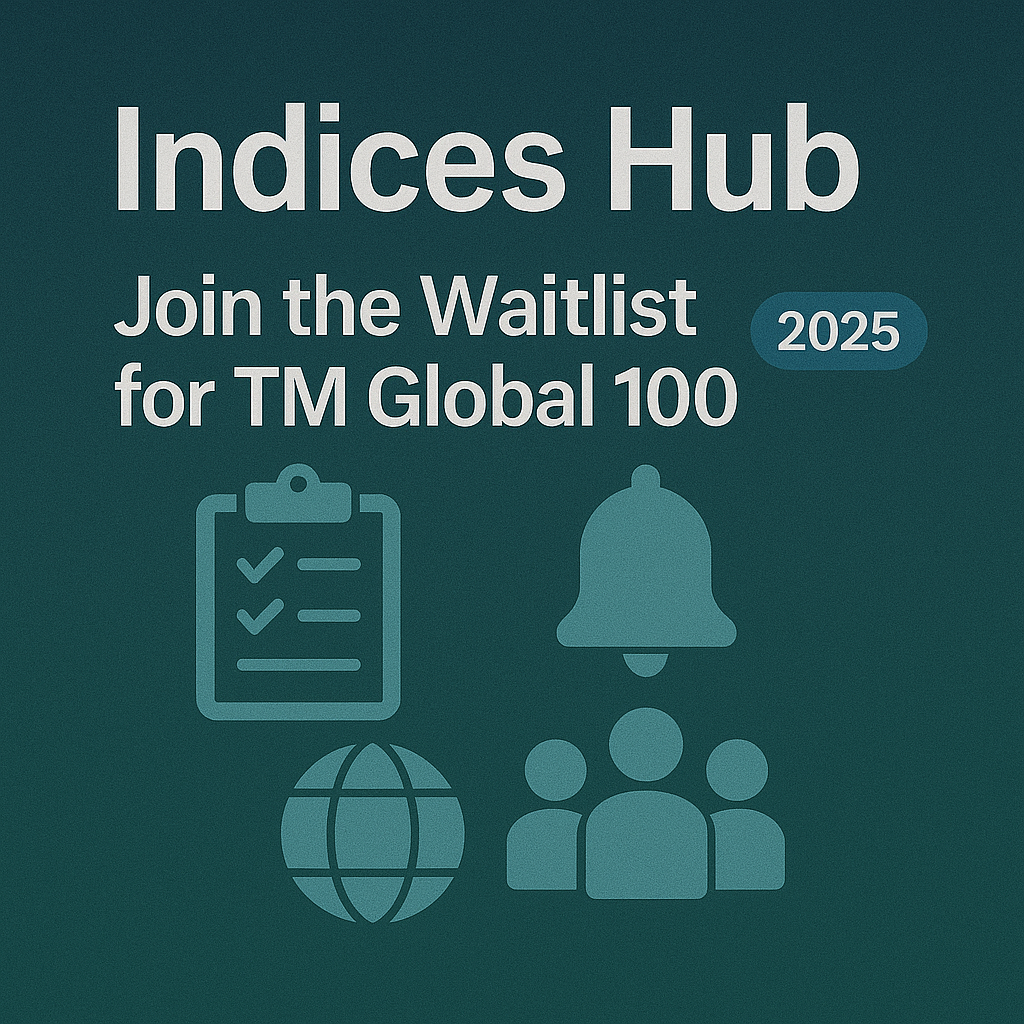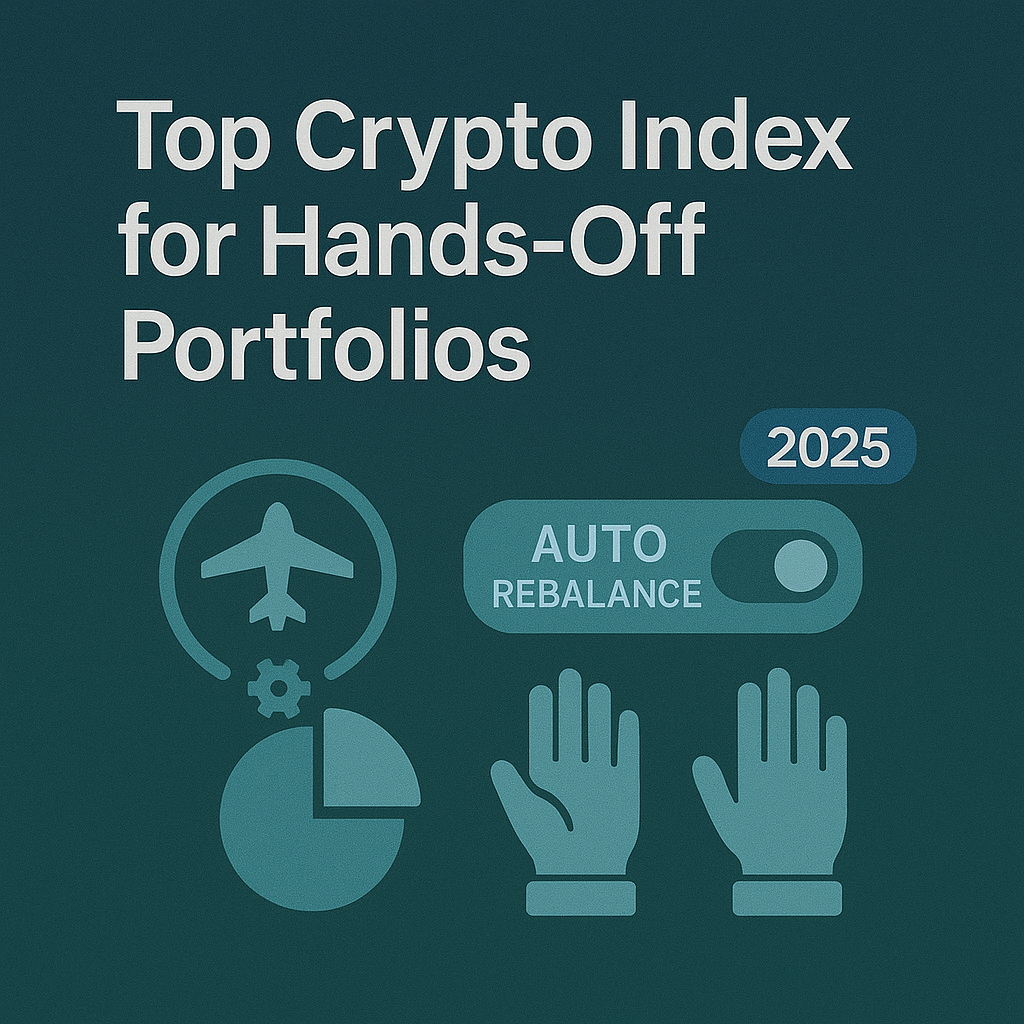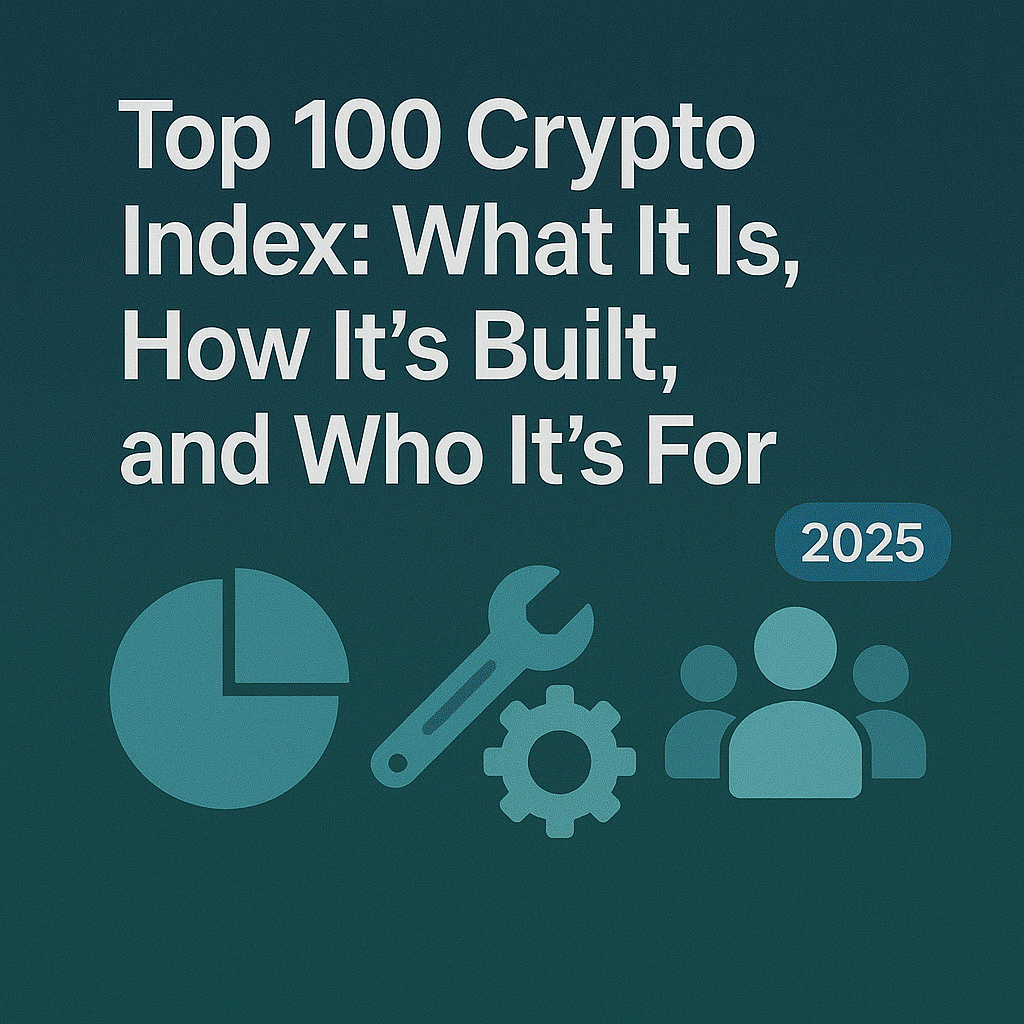Top Crypto Trading Platforms in 2025







%201.svg)
%201.svg)
Big news: We’re cranking up the heat on AI-driven crypto analytics with the launch of the Token Metrics API and our official SDK (Software Development Kit). This isn’t just an upgrade – it's a quantum leap, giving traders, hedge funds, developers, and institutions direct access to cutting-edge market intelligence, trading signals, and predictive analytics.
Crypto markets move fast, and having real-time, AI-powered insights can be the difference between catching the next big trend or getting left behind. Until now, traders and quants have been wrestling with scattered data, delayed reporting, and a lack of truly predictive analytics. Not anymore.
The Token Metrics API delivers 32+ high-performance endpoints packed with powerful AI-driven insights right into your lap, including:
Getting started with the Token Metrics API is simple:
At Token Metrics, we believe data should be decentralized, predictive, and actionable.
The Token Metrics API & SDK bring next-gen AI-powered crypto intelligence to anyone looking to trade smarter, build better, and stay ahead of the curve. With our official SDK, developers can plug these insights into their own trading bots, dashboards, and research tools – no need to reinvent the wheel.
%201.svg)
%201.svg)
If you want broad crypto exposure without babysitting charts, a top crypto index is the simplest way to participate in the market. TM Global 100 was designed for hands-off portfolios: when conditions are bullish, the index holds the top 100 crypto assets by market cap; when signals turn bearish, it moves to stablecoins and waits. You get weekly rebalancing, transparent holdings and transaction logs, and a 90-second buy flow—so you can spend less time tinkering and more time compounding your life.
→ Join the waitlist to be first to trade TM Global 100.
Volatility is back, and investors are searching for predictable, rules-based ways to capture crypto upside without micromanaging tokens. Search interest for terms like hands-off crypto investing, weekly rebalancing, and regime switching reflects the same intent: “Give me broad exposure with guardrails.”
Definition (for snippets): A crypto index is a rules-based basket of digital assets that tracks a defined universe (e.g., top-100 by market cap) with a transparent methodology and scheduled rebalancing.
For 2025’s cycle, a top crypto index helps you participate in uptrends while a regime-switching rule can step aside during drawdowns—removing guesswork and FOMO from day-to-day decisions.

Soft CTA: See the strategy and rules.


→ Join the waitlist to be first to trade TM Global 100.


What is a top crypto index?
A rules-based basket that tracks a defined universe—here, the top 100 assets by market cap—with transparent methodology and scheduled rebalancing.
How often does the index rebalance?
Weekly. Regime switches (tokens ↔ stablecoins) can also occur when the market signal changes.
What triggers the move to stablecoins?
A proprietary market-regime signal. In bearish regimes, the index exits token positions to stablecoins and waits for a bullish re-entry signal.
Can I fund with USDC or fiat?
At launch, the embedded wallet will surface supported funding/settlement options based on your chain/wallet. USDC payout is supported when selling; additional on-ramps may follow.
Is the wallet custodial?
No. It’s an embedded, self-custodial smart wallet—you control the keys.
How are fees shown?
Before confirming, the buy flow shows estimated gas, platform fee, max slippage, and minimum expected value.
How do I join the waitlist?
Visit the Token Metrics Indices hub or the TM Global 100 strategy page and tap Join Waitlist.
Crypto is volatile and can lose value. Past performance is not indicative of future results. This article is for research/education, not financial advice.
If you want hands-off, rules-based exposure to crypto’s upside—with a stablecoin backstop in bears—TM Global 100 is built for you. See the strategy, join the waitlist, and be ready to allocate on launch.
Related Reads
%201.svg)
%201.svg)
If you’ve tried to “own the market” in crypto, you’ve felt the pain: chasing listings, juggling wallets, and missing rebalances while prices move. A top 100 crypto index aims to fix that—giving you broad exposure when the market is bullish and standing down when it’s not. TM Global 100 is our rules-based version of that idea: it holds the top-100 by market cap in bull regimes, moves to stablecoins in bear regimes, and rebalances weekly. You can see every rule, every holding, and every rebalance—then buy the index in ~90 seconds with an embedded on-chain flow.
→ Join the waitlist to be first to trade TM Global 100.
The market keeps cycling. New leaders emerge quickly. A “set-and-forget” bag can fall behind, while manual baskets burn hours and rack up slippage. Search interest for crypto index, regime switching, and weekly rebalancing keeps growing because people want a simple, disciplined core that adapts.
Definition (for featured snippets): A top 100 crypto index is a rules-based basket that tracks the largest 100 crypto assets by market cap, typically rebalanced on a schedule to keep weights aligned with the market.
In 2025, that alone isn’t enough. You also need discipline for downtrends. TM Global 100 adds a regime-switching layer to move to stablecoins during bear phases—so you can participate in upside and sit out major drawdowns with a consistent, rules-based approach.
Regime switching:
Weekly rebalancing:
Transparency:
What you’ll see on launch:
Soft CTA: See the strategy and rules.


→ Join the waitlist to be first to trade TM Global 100.


What is a top 100 crypto index?
A rules-based basket tracking the largest 100 assets by market cap, typically with scheduled rebalancing. TM Global 100 adds regime switching to stablecoins during bear markets.
How often does the index rebalance?
Weekly. In addition, if the market signal flips, the entire portfolio may switch between tokens ↔ stablecoins outside the weekly cycle.
What triggers the move to stablecoins?
A proprietary market-regime signal. When it’s bearish, the index exits tokens to stablecoins and waits for a bullish re-entry signal.
Can I fund with USDC or fiat?
On launch, funding options surface based on your connected wallet and supported chains. USDC payouts are supported when selling.
Is the wallet custodial?
The embedded wallet is self-custodial—you control your funds.
How are fees shown?
Before you confirm a buy, you’ll see estimated gas, platform fee, max slippage, and minimum expected value—all up front.
How do I join the waitlist?
Go to the TM Global 100 page or the Indices hub and click Join Waitlist. You’ll get notified at launch with simple steps to buy.
Crypto is volatile and can lose value. Past performance is not indicative of future results. This article is for research/education, not financial advice.
A top 100 crypto index is the simplest path to broad market exposure—if it’s built with discipline. TM Global 100 combines transparent rules, weekly rebalancing, and a regime switch to stablecoins, so you can focus on your strategy while the core maintains itself.
Now’s the time to claim early access.
→ Join the waitlist to be first to trade TM Global 100.
Related Reads
%201.svg)
%201.svg)
After a whipsaw year, many investors are asking how to stay exposed to crypto’s upside without riding every drawdown. Rules-based crypto indexing is a simple, disciplined answer: follow a transparent set of rules rather than gut feelings. The TM Global 100 puts this into practice—own the top-100 in bullish regimes, rotate to stablecoins in bearish regimes, and rebalance weekly. On top of that, you can see what you own in real time with a Holdings Treemap, Table, and Transactions Log. Less second-guessing, more process.
→ Join the waitlist to be first to trade TM Global 100.
What it is: A rules-based index that holds the top-100 in bull markets and moves to stablecoins in bear markets—paired with transparent holdings and transaction logs.
Why it matters: Weekly rebalances and clear regime logic bring structure after volatile cycles.
Who it’s for: Hands-off allocators and active traders who want a disciplined core with visibility.
Next step: Join the waitlist to be first to trade TM Global 100.
In a volatile cycle, emotion creeps in: chasing winners late, cutting losers early, or missing re-entry after fear. Rules-based crypto indexing applies consistent criteria—constituent selection, weighting, and rebalancing—so you don’t have to improvise in stress.
For readers comparing crypto index options, think of it as a codified playbook. A rules-based crypto index is a methodology-driven basket that follows predefined signals (e.g., market regime) and maintenance schedules (e.g., weekly rebalancing), aiming for repeatable behavior across cycles.
Featured snippet definition: Rules-based crypto indexing is a systematic approach that tracks a defined universe (e.g., top-100 by market cap) and maintains it on a fixed cadence, with explicit rules for when to hold tokens and when to de-risk into stablecoins.
See the strategy and rules. (TM Global 100 strategy)


→ Join the waitlist to be first to trade TM Global 100.


What is a rules-based crypto index?
A methodology-driven basket that follows predefined rules for asset selection, weighting, and maintenance. In TM Global 100, that means top-100 exposure in bullish regimes and stablecoins in bearish regimes, with weekly rebalancing and full transparency.
How often does the index rebalance?
Weekly. This cadence refreshes constituents and weights to align with current market-cap rankings; separate regime switches can move between tokens and stablecoins.
What triggers the move to stablecoins?
A documented market signal. When it turns bearish, the index exits to stablecoins; when bullish resumes, it re-enters the top-100 basket.
Can I fund with USDC or fiat?
Funding options will surface based on your connected wallet and supported rails. USDC settlement on sells is supported; fiat on-ramps may be added over time.
Is the wallet custodial?
No. The embedded wallet is self-custodial—you control your keys and assets.
How are fees shown?
Before confirming a trade, you’ll see estimated gas, platform fee, max slippage, and min expected value—so you can proceed with clarity.
How do I join the waitlist?
Go to the Indices hub, open TM Global 100, and enter your email. You’ll receive a launch-day link to buy.
After a volatile cycle, the edge is process. TM Global 100 combines rules-based crypto indexing, weekly rebalancing, and full transparency so you can participate in upside and step aside during bears—without running your own spreadsheets. If that’s the core you’ve been missing, join the waitlist now.
Related Reads:
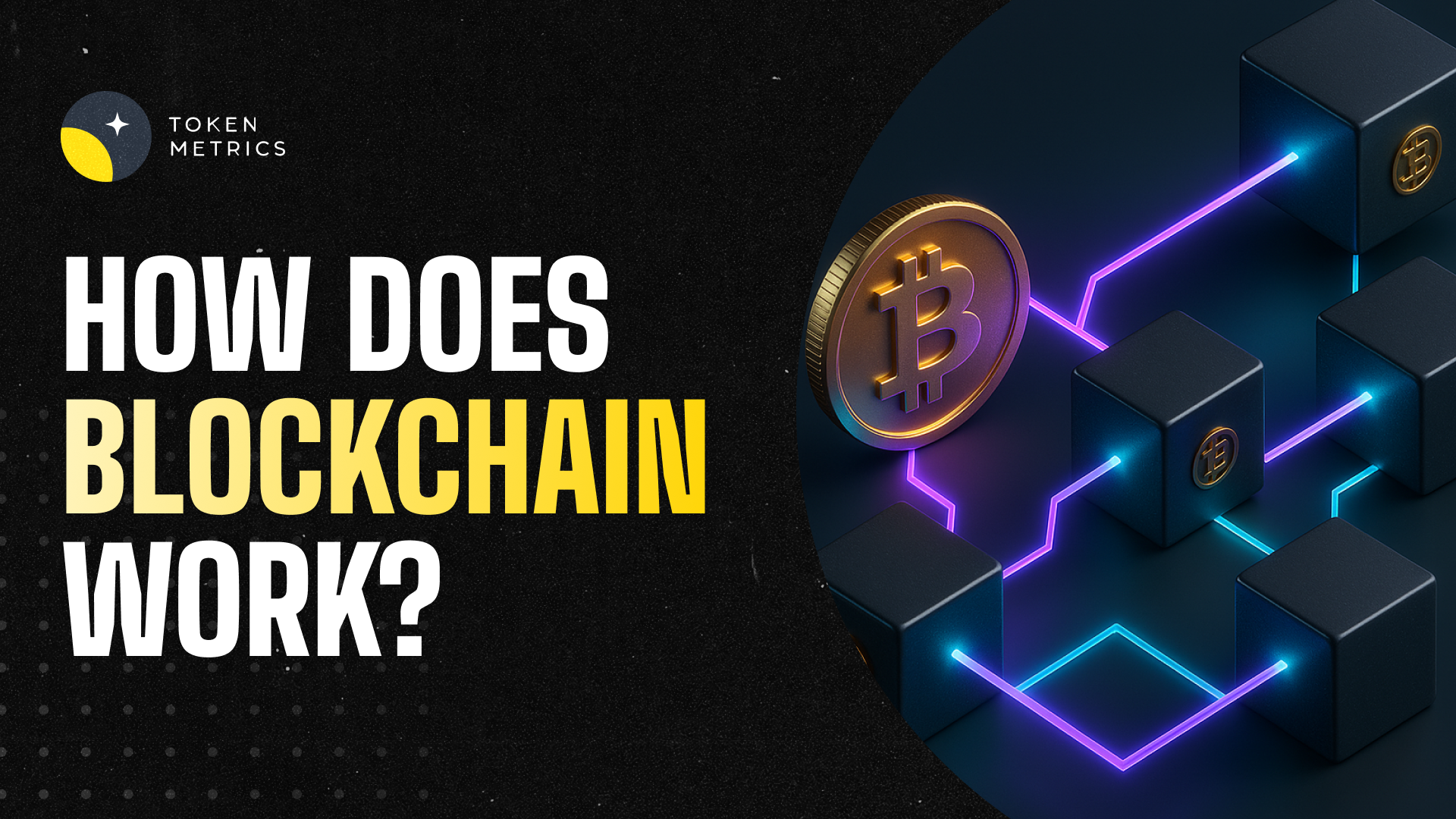
%201.svg)
%201.svg)
Blockchain is the foundation of modern cryptocurrency and one of the most transformative technologies of the digital age. Initially created to support Bitcoin, blockchain has expanded into countless use cases, from decentralized finance (DeFi) to supply chain tracking, real-world asset tokenization, and artificial intelligence (AI) integration.
In 2025, understanding how blockchain works is essential—not just for crypto investors but for anyone navigating the evolving digital economy. This article explains the structure, components, and applications of blockchain in simple terms and explores how platforms like Token Metrics use blockchain data to help investors make smarter decisions.
At its core, blockchain is a distributed digital ledger that records transactions across a network of computers. Unlike traditional databases controlled by a single entity, blockchain operates on a decentralized network, making it secure, transparent, and tamper-resistant.
Each entry in this ledger is grouped into a “block,” and these blocks are linked (or chained) together in chronological order—hence the name blockchain.
Consensus mechanisms are protocols that ensure all nodes agree on the state of the blockchain.
In 2025, hybrid models combining public and private features are increasingly popular for balancing transparency with privacy.
Platforms like Token Metrics take blockchain a step further by:
By combining blockchain transparency with AI-powered analytics, Token Metrics provides a comprehensive view of crypto investments.
In 2025, blockchain continues to evolve beyond cryptocurrencies. With advances in scalability solutions, real-world asset tokenization, and AI integration, blockchain is shaping the next generation of financial systems, digital identity solutions, and decentralized applications.
As enterprises, governments, and investors adopt blockchain, its role in the digital economy will only grow.
Blockchain is more than a buzzword—it’s a transformative technology driving innovation across industries. By understanding how blockchain works—its structure, consensus mechanisms, and applications—you can better navigate the crypto market and the broader digital landscape.
Platforms like Token Metrics make blockchain analysis accessible and actionable, offering AI-driven insights to help investors capitalize on this rapidly expanding technology. In 2025, mastering blockchain fundamentals isn’t just helpful—it’s essential for participating in the future of finance and digital ownership.

%201.svg)
%201.svg)
In the fast-paced world of cryptocurrency investing, market capitalization, often called market cap, is one of the most essential metrics for evaluating projects. It helps investors quickly gauge a coin’s size, value, and growth potential, making it a cornerstone for portfolio allocation and risk management.
Whether you’re a beginner trying to understand which cryptocurrencies to buy or an experienced trader managing a complex portfolio, understanding coin market cap is critical. In this guide, we’ll break down what market cap is, how to use it effectively, its limitations, and how platforms like Token Metrics can enhance your analysis with advanced data insights.
Market capitalization refers to the total value of a cryptocurrency in circulation. It’s calculated using a simple formula:
Market Cap=Current Price×Circulating Supply\text{Market Cap} = \text{Current Price} \times \text{Circulating Supply}

For example, if a cryptocurrency is priced at $20 and has 50 million coins in circulation, its market cap would be $1 billion. This figure provides a snapshot of the project’s relative size and its standing in the broader crypto market.
Market cap is an invaluable metric for quickly comparing projects, identifying potential opportunities, and understanding the level of risk associated with an investment.
Market cap plays a crucial role in crypto investing for several reasons:
Cryptocurrencies are typically categorized by their market cap:
While market cap is only one part of the puzzle, it’s a powerful tool when used correctly. Here’s how to incorporate it into your strategy:
Although market cap is a useful metric, it has its shortcomings:
This is why market cap analysis should always be combined with other key metrics and qualitative research, which is where Token Metrics becomes invaluable.
While traditional market cap data offers a snapshot, Token Metrics goes deeper by analyzing:
This AI-powered approach allows investors to identify truly undervalued projects that might be overlooked by simply glancing at market cap.
Market cap is most powerful when used alongside:
Combining these insights with market cap offers a more complete view of a project’s health and potential.
Coin market cap remains one of the most fundamental metrics for analyzing cryptocurrencies. It provides a clear picture of project size and helps investors allocate capital effectively.
However, market cap alone isn’t enough. To make smarter, data-driven decisions, investors should combine market cap insights with on-chain data, technical analysis, and AI-driven insights from Token Metrics.
In 2025, using market cap alongside advanced analytics can help you identify undervalued opportunities, manage risk effectively, and build a balanced, growth-oriented crypto portfolio.

%201.svg)
%201.svg)
Over the past decade, cryptocurrency has moved from an experimental technology to a mainstream investment asset. What started with Bitcoin as a digital alternative to cash has evolved into a multi-trillion-dollar ecosystem encompassing altcoins, decentralized finance (DeFi), AI-powered tokens, and NFTs.
In 2025, crypto is no longer a fringe idea—it’s an essential consideration for forward-thinking investors. Whether you’re seeking growth, diversification, or a hedge against inflation, crypto offers multiple paths to wealth creation. This article explores why crypto is a valuable investment, how to approach it strategically, and the role of Token Metrics in making data-driven decisions.

Mitigate these risks by conducting thorough research and using Token Metrics AI to assess tokens based on fundamentals, on-chain activity, and market sentiment.

Token Metrics is a game-changing platform for crypto investors. It provides AI-powered coin ratings, trend analysis, and portfolio management tools. With over 80 data points per token, it helps investors identify undervalued coins and time market entries effectively.
In 2025, crypto remains a compelling investment option for those willing to manage its risks. By leveraging Token Metrics for data-driven insights and combining long-term strategies with diversified holdings, investors can position themselves for strong returns in the evolving digital asset landscape.

%201.svg)
%201.svg)
As the cryptocurrency market evolves, altcoins—cryptocurrencies other than Bitcoin—are becoming increasingly central to the digital asset ecosystem. Investing in altcoins can provide opportunities for higher returns, portfolio diversification, and exposure to innovative blockchain technologies.
Unlike Bitcoin, which is primarily seen as digital gold, altcoins serve varied purposes, such as powering decentralized applications, enabling smart contracts, or facilitating cross-border payments. In 2025, altcoin investments are gaining momentum among both retail and institutional investors, offering unique opportunities in emerging sectors like artificial intelligence (AI), decentralized finance (DeFi), and real-world asset tokenization.
Altcoins are cryptocurrencies designed as alternatives to Bitcoin. They differ in technology, use case, and governance structure, making them essential to a diversified crypto portfolio.
Categories of Altcoins include:

By investing in a mix of these categories, investors gain exposure to multiple narratives driving the crypto market forward.
Investing in altcoins involves buying and holding tokens, trading them for profit, or staking them for passive income. The process starts with choosing a reliable cryptocurrency exchange, creating a secure wallet, and identifying which tokens fit your portfolio strategy.
Key steps for altcoin investment:
1. Higher Growth Potential:
Altcoins often outperform Bitcoin during bull markets. Projects in sectors like AI, DeFi, and NFTs can yield outsized returns when demand surges.
2. Diversification:
Altcoins provide exposure to multiple sectors, reducing reliance on Bitcoin’s price movements.
3. Innovation:
Many altcoins drive technological breakthroughs in blockchain scalability, privacy, and decentralized governance.
4. Passive Income Opportunities:
Through staking and yield farming, investors can earn consistent returns on altcoin holdings.
While altcoins can deliver impressive gains, they also carry significant risks:
Mitigating these risks involves thorough research, diversification, and using analytics tools to assess project viability.
Bitcoin is considered a store of value, while altcoins offer greater utility and innovation. Here’s how they compare:
A balanced strategy typically includes Bitcoin for security and altcoins for growth.
Investing securely in altcoins requires:
Altcoins often face different regulatory classifications than Bitcoin, especially tokens associated with securities or DeFi platforms. In 2025, governments are increasingly requiring Know Your Customer (KYC) and Anti-Money Laundering (AML) compliance for crypto platforms.
Investors should ensure they use regulated exchanges and stay informed about local laws affecting altcoin trading.
When selecting altcoins to invest in:
In 2025, altcoins are poised to play a transformative role in finance, AI integration, and global blockchain adoption. Tokens tied to AI analytics, DeFi platforms, and real-world assets are expected to lead the next wave of growth.
Altcoin investment is more than a high-risk gamble—it’s a way to participate in the future of digital finance. By understanding altcoins’ categories, benefits, risks, and strategies, investors can make informed decisions and unlock substantial growth opportunities.
With the right tools, like AI-powered analytics from Token Metrics, and a disciplined approach, altcoins can become a cornerstone of a well-balanced crypto portfolio in 2025 and beyond.
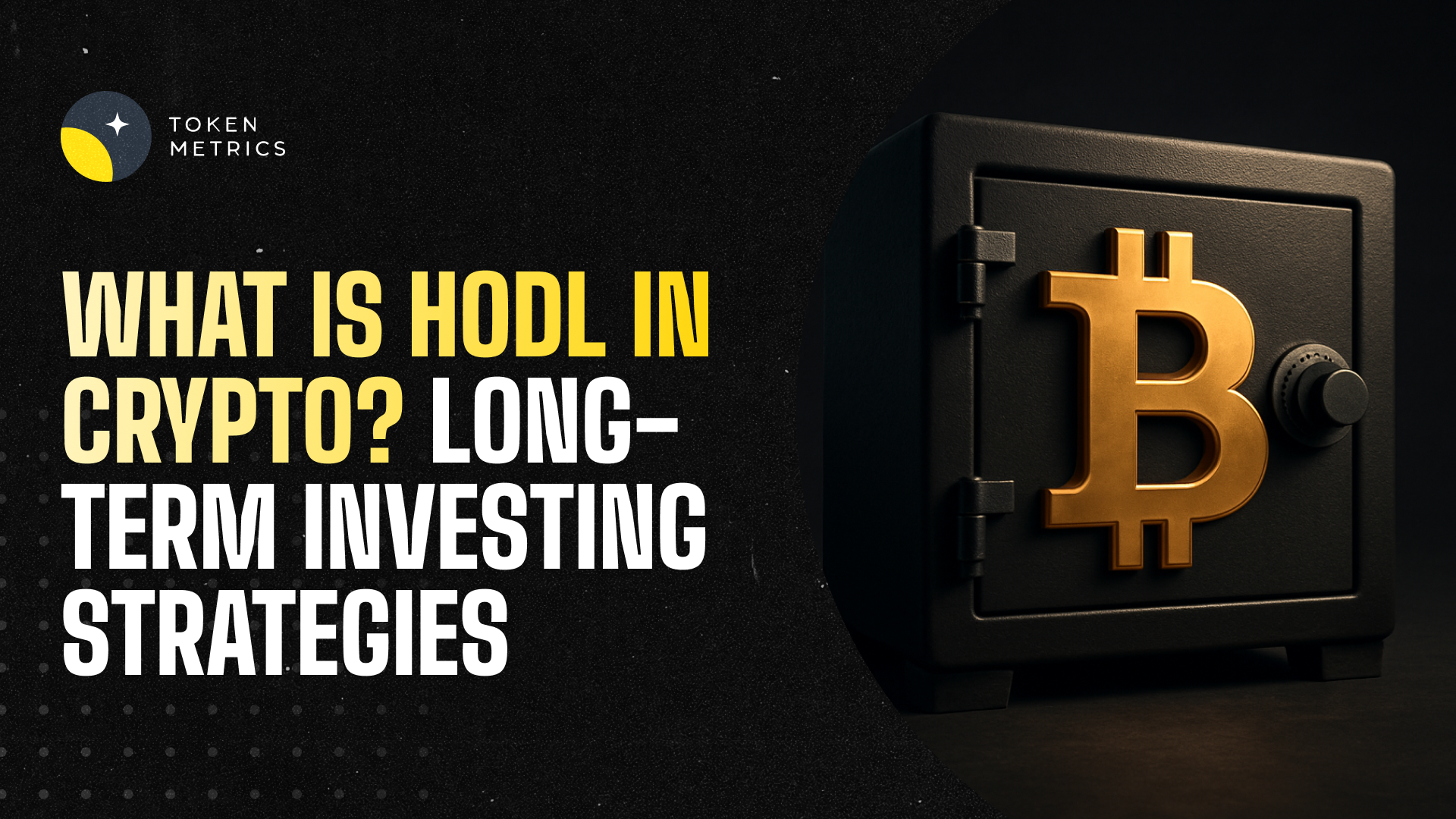
%201.svg)
%201.svg)
If you’ve spent any time in cryptocurrency communities, you’ve likely seen the term HODL. Originally a misspelling of “hold” on an online Bitcoin forum in 2013, HODL has become much more than a typo—it’s now a core investment philosophy for crypto enthusiasts worldwide.
In 2025, HODLing remains one of the most effective long-term strategies for building wealth in cryptocurrency. By holding onto fundamentally strong assets through market volatility, investors can capture long-term gains while avoiding emotional, short-term trading mistakes. This article explores what HODLing means, why it works, the best assets to HODL, and how platforms like Token Metrics can help optimize your strategy.
HODL means buying and holding cryptocurrency for an extended period, regardless of short-term price fluctuations. Unlike traders who attempt to time the market, HODLers adopt a long-term mindset, trusting that the value of quality assets will increase over time.
This strategy is rooted in the belief that blockchain technology and digital assets are here to stay, and that short-term market noise shouldn’t derail long-term conviction.
Crypto markets are notoriously volatile, with sudden price swings that can lead to emotional decision-making. HODLing combats this by:
By committing to HODLing, investors can overcome emotional biases and stay focused on their long-term goals.
While any coin can be HODLed, the best long-term candidates are projects with strong fundamentals, proven track records, and growing ecosystems:

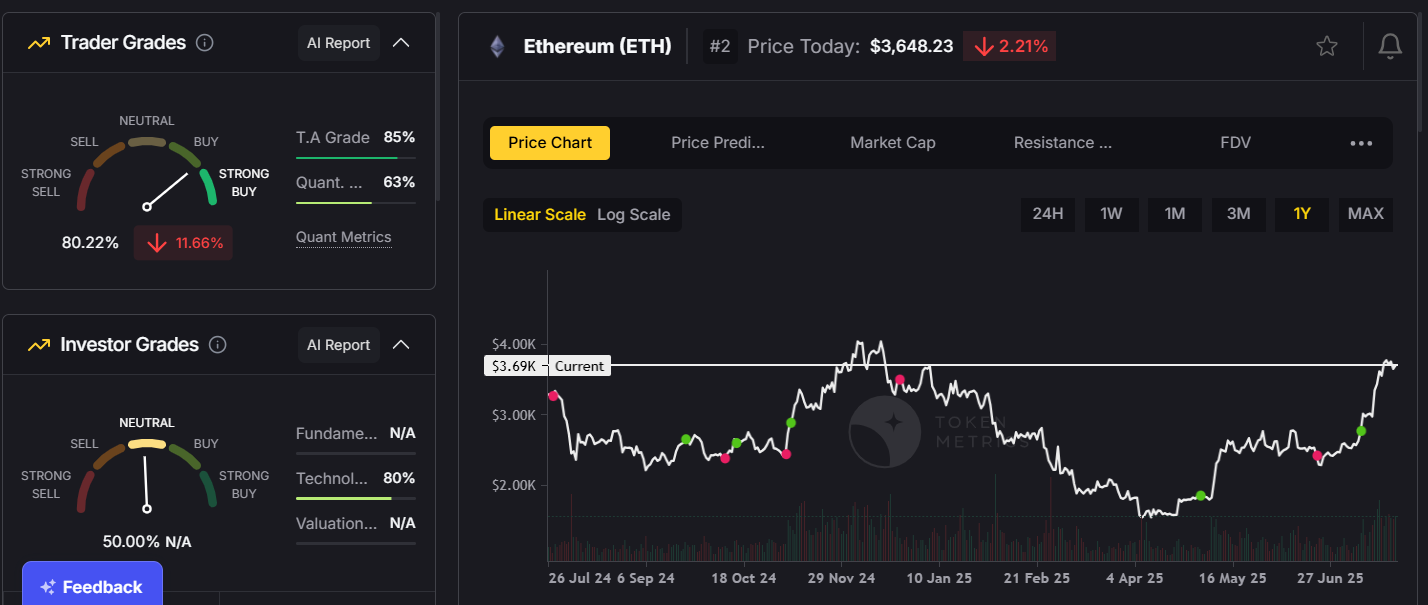
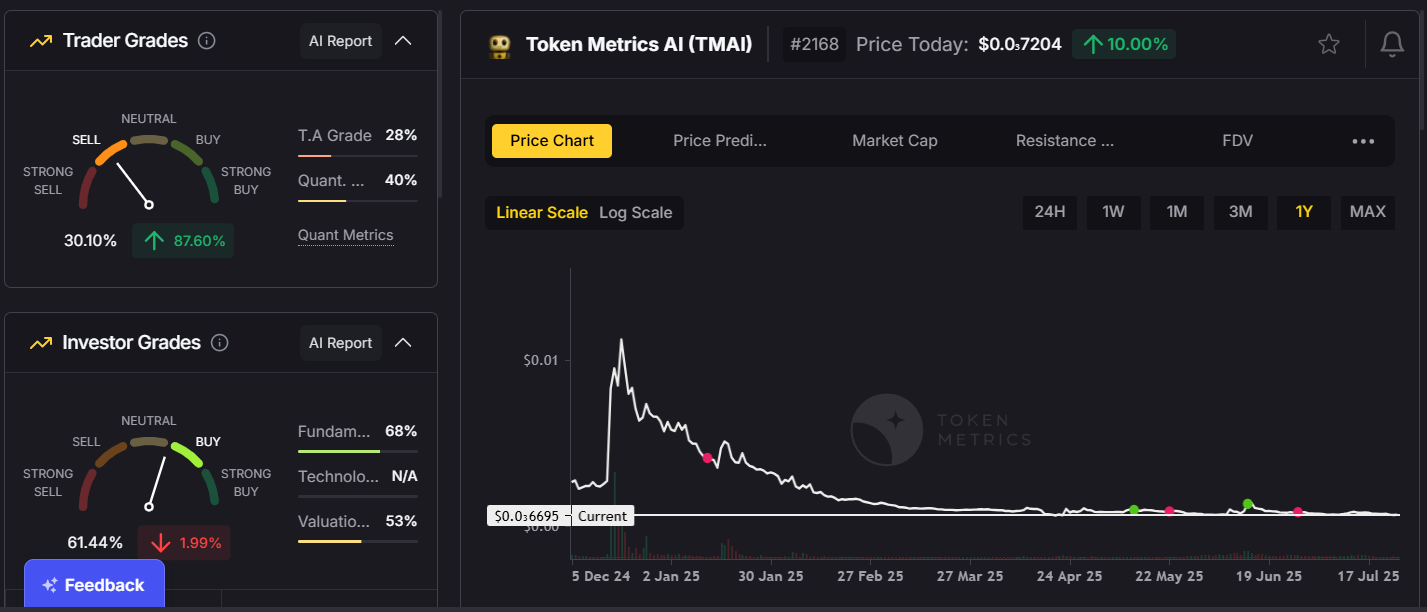
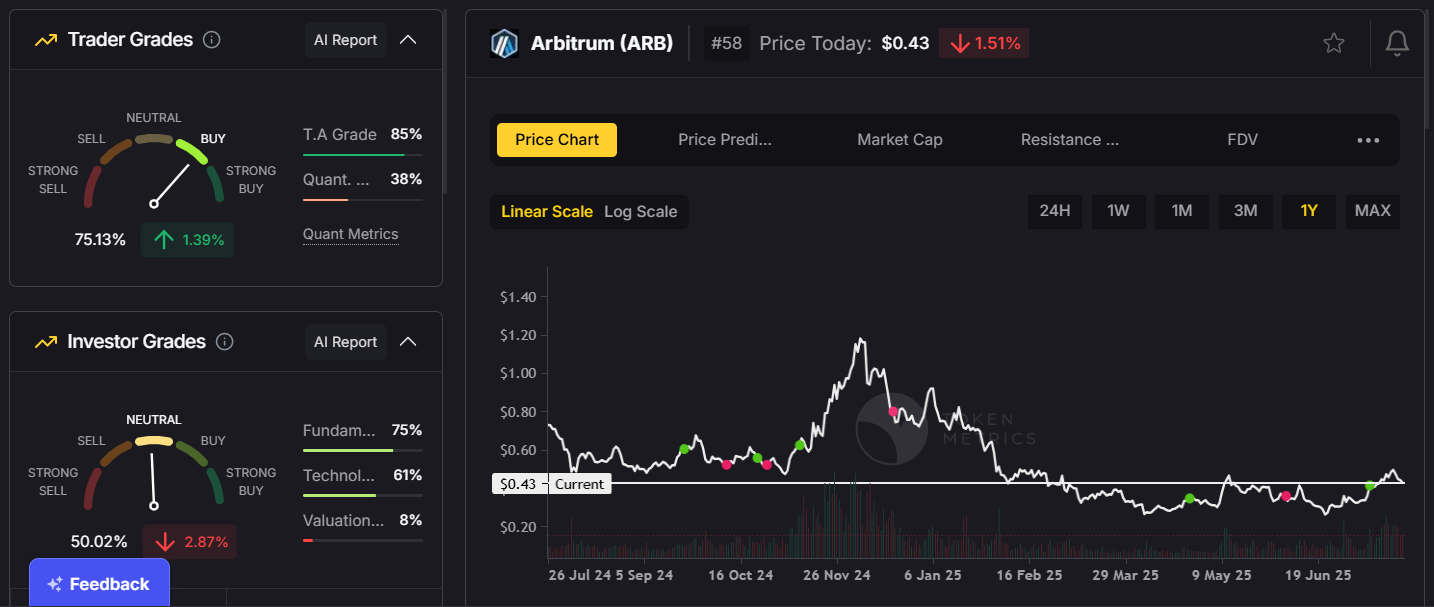
These coins offer long-term growth potential, making them excellent candidates for a HODL strategy.
While active trading can generate quick profits, it also comes with higher risks and costs. Here’s how HODLing compares:
Platforms like Token Metrics can complement both approaches by providing trading signals and long-term portfolio analytics, helping you decide when (and if) you should adjust your positions.
While HODLing is effective, it’s not without challenges:
To mitigate these risks, rely on data-driven tools like Token Metrics to ensure you’re holding the right mix of assets.
Token Metrics is a powerful platform for long-term crypto investors, providing:
By leveraging AI analytics, Token Metrics makes HODLing smarter, ensuring you’re invested in assets with strong fundamentals and growth potential.
HODLing isn’t just a meme—it’s a time-tested strategy for building wealth in crypto. By holding onto fundamentally strong assets, you can capture long-term growth while avoiding the emotional traps of active trading.
In 2025, pairing HODLing with AI-powered insights from Token Metrics gives you an edge—helping you select the right assets, manage risk, and stay committed to your investment plan. Whether you’re a beginner or a seasoned investor, HODLing remains one of the simplest and most effective ways to build wealth in the dynamic world of cryptocurrency.
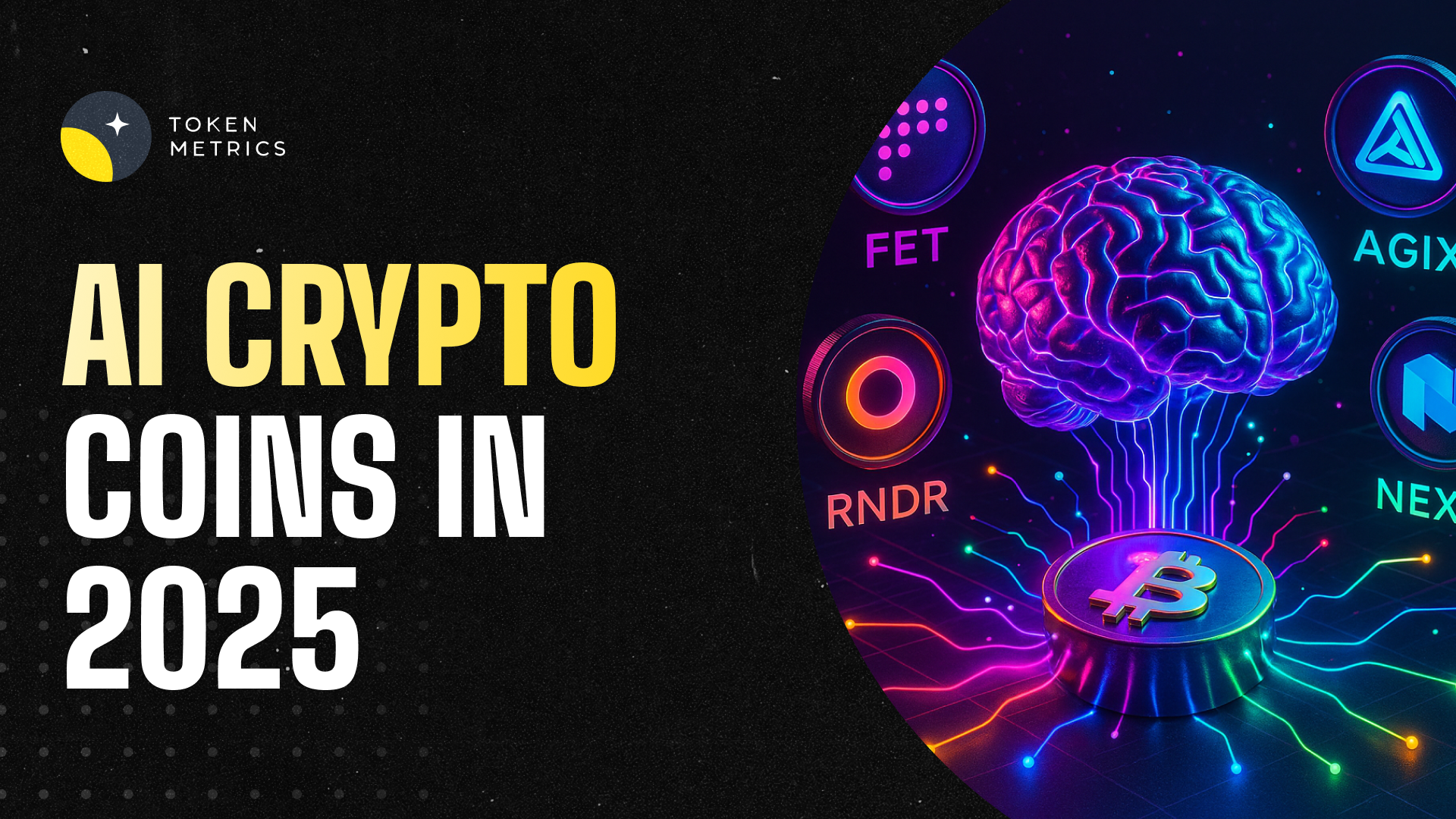
%201.svg)
%201.svg)
Artificial intelligence (AI) has become one of the most transformative technologies of our time, reshaping industries from healthcare to finance. In the cryptocurrency space, AI crypto coins are merging blockchain with artificial intelligence, creating powerful ecosystems for data analytics, automated decision-making, decentralized AI marketplaces, and predictive trading.
In 2025, AI-powered tokens are one of the most promising sectors in crypto, attracting retail investors, institutional players, and developers seeking the next wave of technological breakthroughs. This article explores what AI crypto coins are, how they work, their benefits, key risks, and the role of Token Metrics in analyzing and investing in them.
AI crypto coins are digital tokens that fuel blockchain platforms integrated with artificial intelligence technologies. These coins serve multiple purposes, including:
By combining the transparency of blockchain with the intelligence of AI, these projects are creating self-sustaining ecosystems where users can buy, sell, and deploy AI services securely.
The AI crypto sector is diverse, with projects addressing various use cases. Here are some of the leading tokens:
One of the most innovative AI-driven analytics platforms in crypto. TMAI leverages over 80 data points per token, offering AI-generated ratings, trend analysis, and portfolio insights to help traders and investors make data-driven decisions.
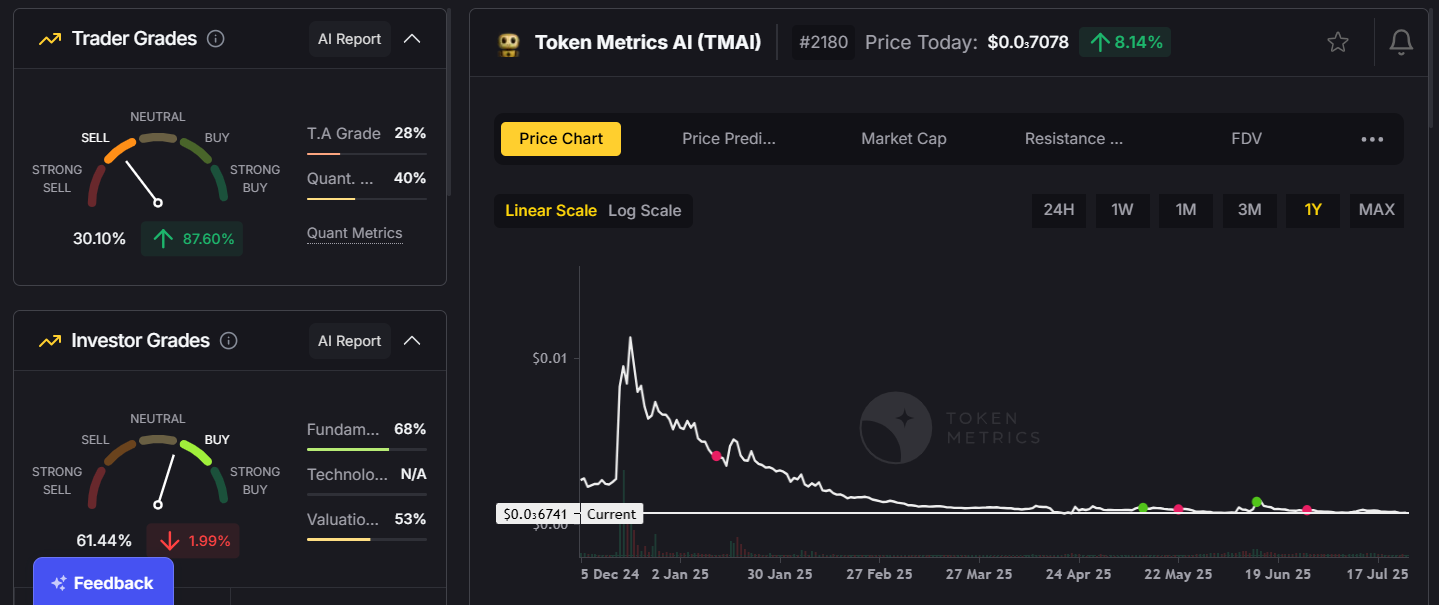
2. $KAITO Token Utility:
3. Cookie.fun ($COOKIE): Gamified Trading Meets A
Cookie.fun is a Gen-Z-targeted platform that fuses AI-powered trading insights with gamified investing experiences.
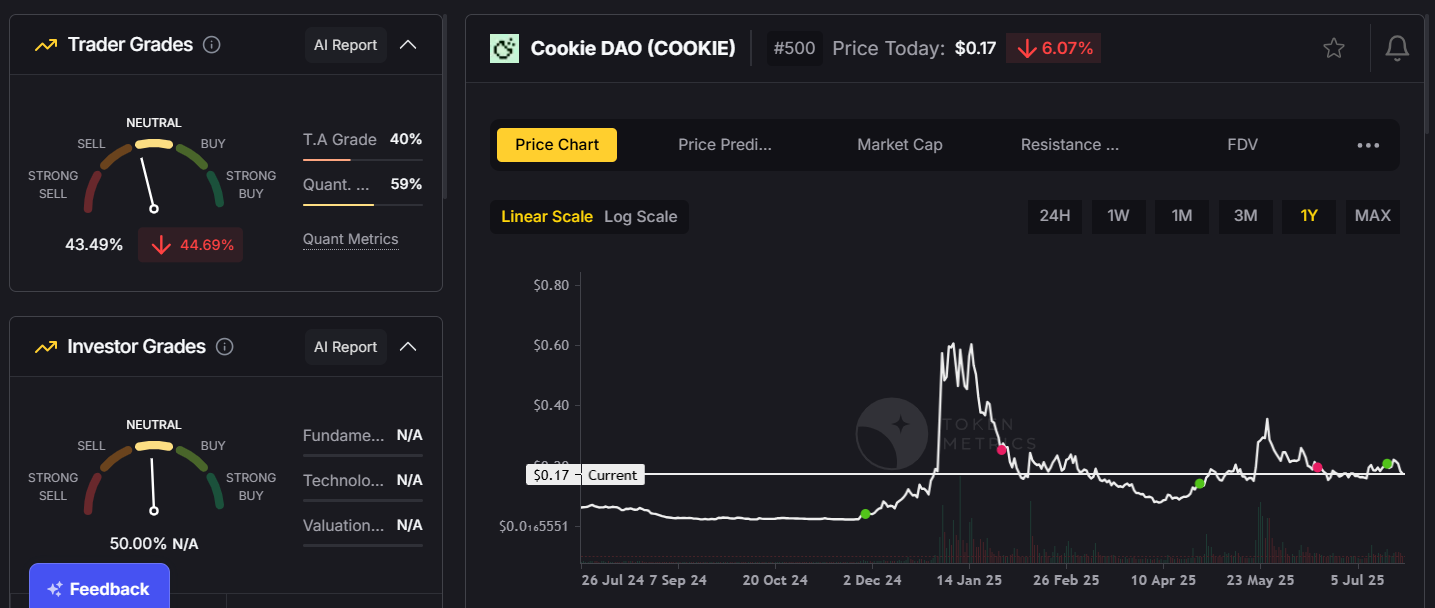
4. Arkham Intelligence (ARKM):
An AI-powered blockchain intelligence platform that analyzes on-chain data for compliance, forensics, and research.

These tokens are part of a fast-growing ecosystem of AI-focused projects poised to disrupt industries ranging from financial trading to decentralized computing.
AI crypto coins work by integrating machine learning and blockchain to create scalable, secure, and transparent AI ecosystems. Key mechanisms include:
This synergy between AI and blockchain creates systems that learn, adapt, and evolve over time, making them highly valuable in the crypto economy.
1. Exposure to Two Revolutionary Technologies:
Investing in AI tokens means gaining exposure to both the blockchain and AI sectors, which are projected to experience massive growth over the next decade.
2. High Growth Potential:
AI crypto coins often see rapid adoption due to their real-world applications and strong narratives.
3. Diversification:
AI tokens provide a unique asset class within the crypto market, helping diversify a portfolio beyond standard altcoins.
4. Early Access to Innovation:
Investors can be part of groundbreaking projects building the infrastructure for decentralized AI networks.
Like all crypto assets, AI coins carry risks:
Using data-driven platforms like Token Metrics can help mitigate these risks by offering detailed project analysis and ratings.
1. Long-Term Holding (HODL):
Invest in leading AI tokens like TMAI, FET, and AGIX for long-term exposure to this emerging sector.
2. Narrative Investing:
Capitalize on market narratives by entering early when AI projects gain traction or announce major updates.
3. Portfolio Diversification:
Balance AI tokens with large-cap cryptocurrencies like Bitcoin and Ethereum to manage overall portfolio risk.
4. Active Monitoring with Token Metrics:
Use Token Metrics to receive real-time AI-generated ratings, alerts, and trend analyses for AI tokens, helping you optimize entry and exit points.
Token Metrics is uniquely positioned at the intersection of AI and crypto. It provides:
For investors seeking to navigate the fast-changing AI crypto sector, Token Metrics delivers data-driven confidence in decision-making.
AI crypto coins are expected to play a transformative role in 2025 and beyond, powering innovations in:
As AI becomes more integrated with blockchain, these coins will likely lead the next technological and financial revolution.
AI crypto coins represent one of the most exciting frontiers in cryptocurrency. By merging the power of blockchain with the intelligence of AI, these tokens are reshaping how we interact with data, trade, and build decentralized systems.
For investors, platforms like Token Metrics provide the insights needed to navigate this dynamic sector—identifying promising projects, managing risk, and seizing opportunities before the market catches up.
In 2025, adding AI tokens to your portfolio isn’t just an investment—it’s a way to participate in the future of intelligent, decentralized finance.
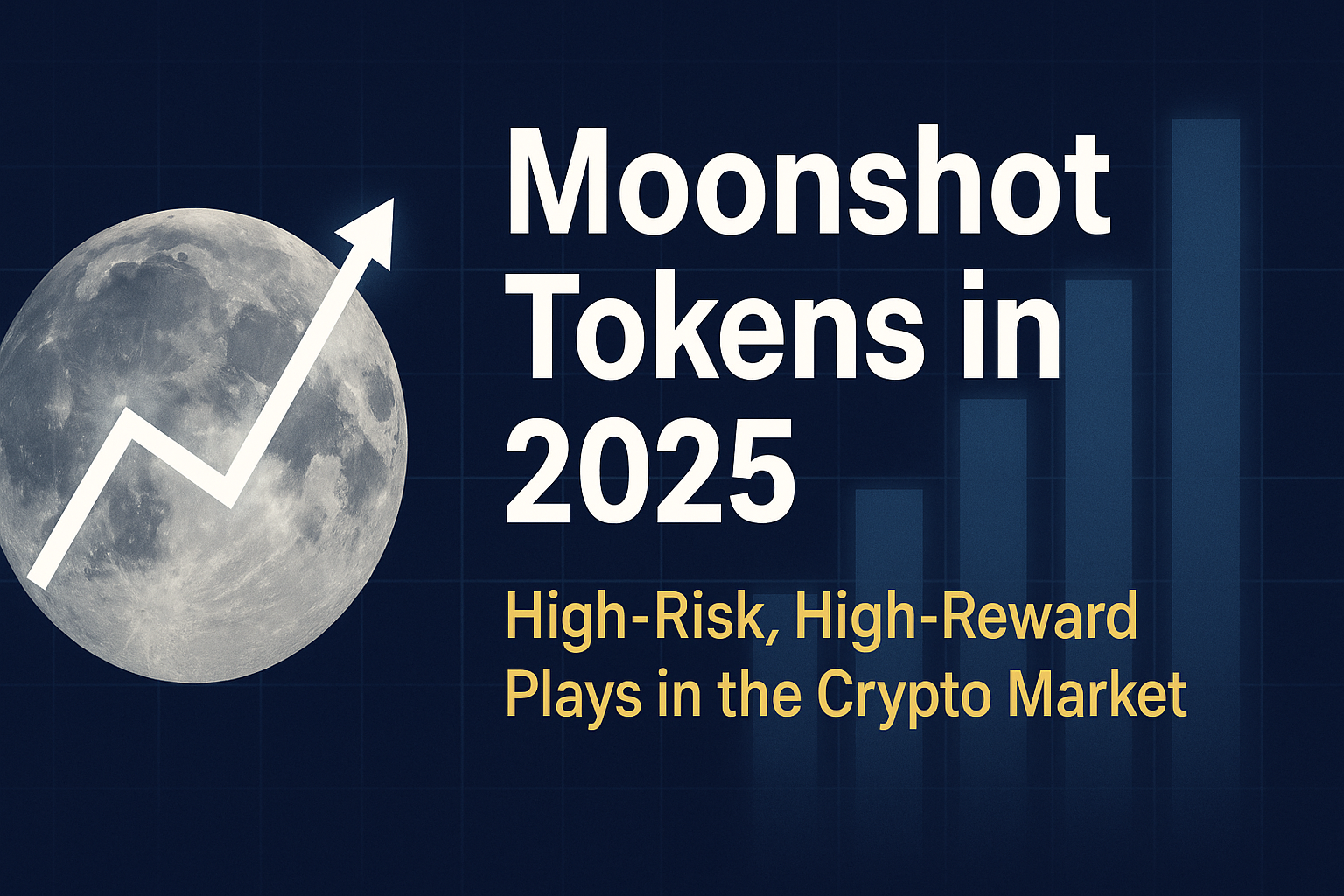
%201.svg)
%201.svg)
The crypto market has always been fertile ground for high-risk, high-reward opportunities. While blue-chip assets like Bitcoin and Ethereum dominate headlines, the real thrill — and sometimes the highest returns — often comes from what the industry calls “moonshots.”
These are small-cap tokens, often under $50 million in market cap, with explosive potential and equally high volatility. In 2025, moonshots remain a core part of speculative trading strategies. But what exactly are they? How do you find them? And most importantly, how can you manage the outsized risks they carry?
Let’s dive into the world of moonshots, drawing insights from recent market trends and real-world data.
Moonshot tokens are early-stage, low-cap cryptocurrencies that carry massive upside potential. They often represent experimental ideas or emerging narratives — think AI integration, meme culture, or social tokens — that haven’t yet been fully recognized by the broader market.
Because they trade at relatively low valuations, even small inflows of capital can cause outsized price swings. It’s not uncommon for a moonshot to deliver 10x or even 50x gains within a short time. But the flip side is brutal: these same tokens can plummet to zero just as quickly.
Key characteristics of moonshots:
The current market environment — with crypto market capitalization hovering around $4 trillion — has created room for risk-taking. Investors who missed early gains on Bitcoin or Ethereum are now searching for the next big thing, leading to renewed interest in small-cap tokens.
Emerging narratives also fuel the fire:
These narratives often spill over into the moonshot arena, as smaller projects attempt to replicate the success of these headline-grabbing platforms.
Identifying moonshots is part research, part intuition, and part risk tolerance. Here’s what to look for:
The most successful moonshots ride on current narratives. In this cycle, AI agents, decentralized social platforms, and community-owned DeFi projects are leading themes. Projects in these categories often experience rapid hype-driven adoption.
Tools like Dune Analytics and on-chain scanners can reveal whale accumulation, new liquidity pools, or spikes in active addresses — all early indicators of growing interest.
Evaluate supply schedules:
While many moonshots are grassroots projects, strong teams or backing from reputable funds (e.g., Polychain, Binance Labs) can boost credibility.
1. Vine (Meme Token):
A meme coin leveraging the Vine brand, this token has gained traction despite limited documentation. Its appeal lies largely in nostalgia and speculative hype.
2. Moby AI: What started as an AI-driven whale-tracking agent has evolved into Mobi Screener, a Dexscreener competitor with integrated social features. The token model ties platform usage to token value — a promising experiment in utility-driven moonshots.
3. Graphite Protocol:
Developers behind Bonk Fun (a leading meme token platform), Graphite has created a buyback and burn model linked to Bonk’s success, aligning token value directly with ecosystem growth.
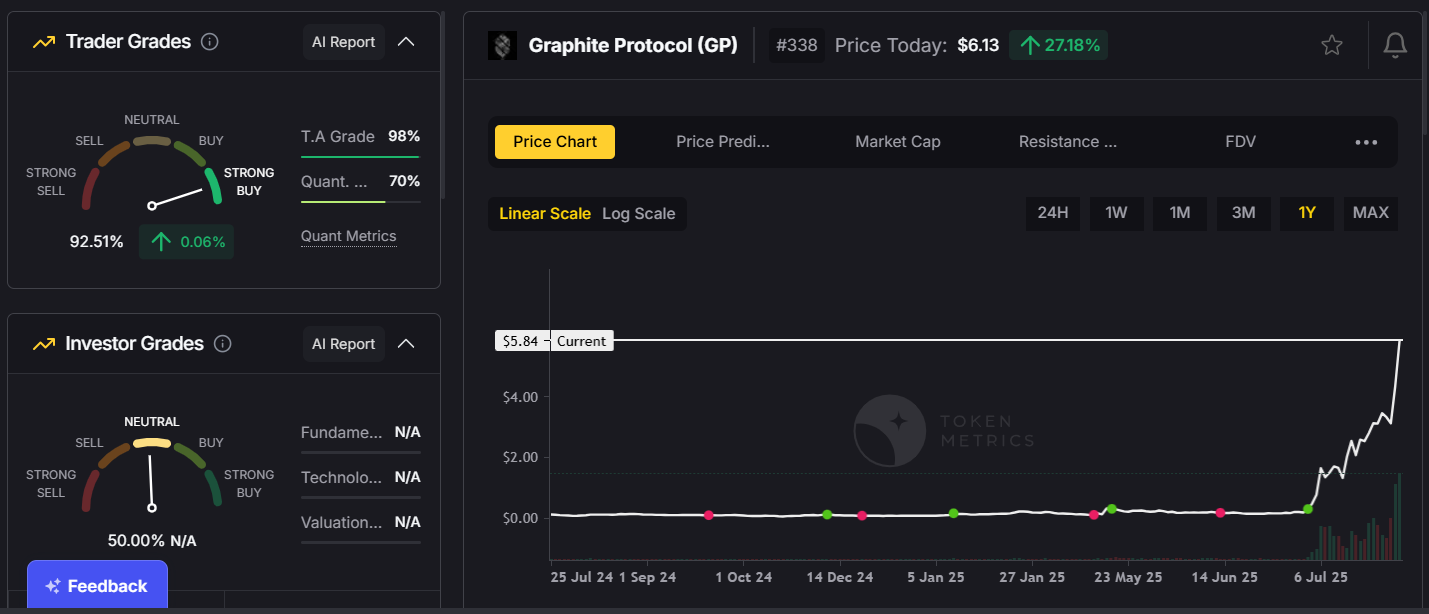
4. CookieDAO:
Initially positioned as an AI agent platform, CookieDAO is now expanding into proof-of-belief systems, adding new utilities and campaign features for Web3 projects.
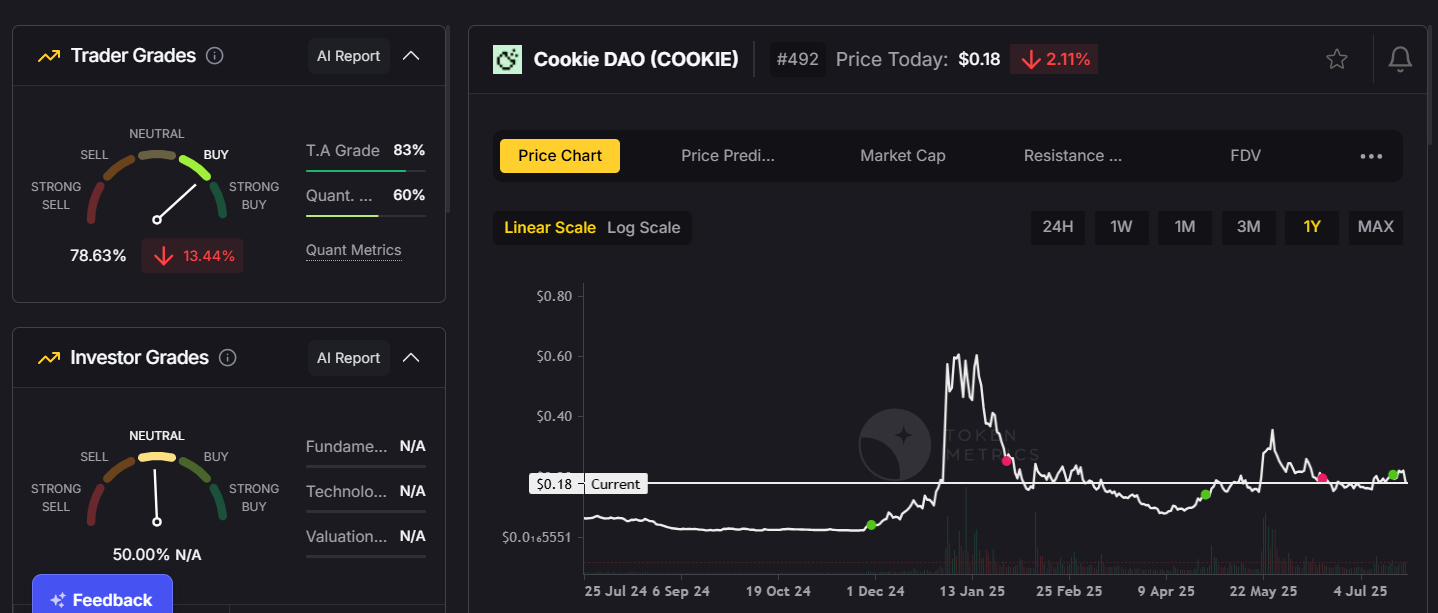
Moonshots are inherently speculative. Common pitfalls include:
A recent example is SpaceMesh, once hyped as a “next Bitcoin.” Despite strong tech, internal disputes and poor execution led to a near-total collapse — a stark reminder that good code doesn’t always equal good investment.
If you’re trading moonshots, risk management is everything.
1. Position Sizing:
Never allocate more than 1% of your portfolio to any single moonshot. Spreading capital across multiple small positions reduces the impact of one token collapsing.
2. Diversification:
Balance moonshots with higher-cap tokens to stabilize overall portfolio performance.
3. Predefined Exits:
Set clear take-profit and stop-loss levels before entering a trade. Emotional decisions often lead to losses.
4. Time Your Entries:
Consider entering after initial hype cools but before major announcements or roadmap milestones.
While moonshots can be risky, they remain an integral part of crypto’s DNA. For many traders, they serve as lottery tickets in a market where early discovery can lead to life-changing gains.
In 2025, moonshots are evolving. They’re no longer just meme-driven gambles. Increasingly, they represent experimental innovation — blending DeFi models, AI integrations, and community governance in ways that push the boundaries of blockchain technology.
Moonshots are not for the faint-hearted. They require research, timing, and above all, discipline. In 2025, with themes like AI-driven platforms, decentralized social networks, and community-focused DeFi reshaping the market, the next breakout token could be hiding in plain sight.
Whether you’re a seasoned trader or a curious newcomer, understanding the dynamics of moonshots — and respecting their risks — is essential for navigating this volatile but potentially rewarding segment of crypto.

%201.svg)
%201.svg)
The cryptocurrency market continues to show resilience, with total market capitalization maintaining a strong foothold near $4 trillion. While Bitcoin remains the cornerstone of this cycle, the spotlight is shifting toward altcoins — especially those at the forefront of decentralized finance (DeFi) and artificial intelligence (AI) integration.
In this blog, we’ll explore the top narratives shaping today’s market, focusing on DeFi protocols like Blackhole DEX and PancakeSwap, alongside emerging AI projects such as Sahara AI and Moby AI.
DeFi has staged an impressive comeback in 2025. After a period of stagnation, several protocols have redefined their models to prioritize community engagement and sustainable growth.
Black Hole DEX:
Launched on Avalanche, Blackhole DEX has quickly become the network’s largest decentralized exchange, overtaking Trader Joe. The platform uses a community-first approach: no team allocation, weekly token emissions to liquidity providers, and a bribe-based voting mechanism for rewards distribution.
Impact:
This design has created a powerful flywheel effect. As token prices rise, APYs increase, attracting more liquidity, which in turn boosts trading volume and revenue. Within days, Blackhole DEX grew its TVL from $7 million to $193 million — a staggering feat.
PancakeSwap, the dominant DEX on Binance Smart Chain (BSC), has been quietly outperforming its competitors in trading volumes and fee generation. Recent data shows PancakeSwap generating more than 4x the daily fees of Uniswap, yet its fully diluted valuation remains significantly lower.

Growth Catalysts:
For investors seeking a large-cap DeFi protocol with strong fundamentals and potential upside, PancakeSwap’s metrics warrant attention.
Artificial intelligence continues to transform multiple industries, and crypto is no exception.
Sahara AI:
Sahara AI is building a full-stack AI infrastructure for decentralized applications. Backed by heavyweights like Binance and Polychain, its mission is to bridge Web3 and AI — a theme that’s likely to dominate innovation cycles in the coming years.

Moby AI:
Initially launched as an AI trading agent, Moby AI has expanded into building tools like Moby Screener, a competitor to Dexscreener. Its unique tokenomics link user engagement directly to the platform’s utility, making it an experiment worth watching.

Beyond DeFi and AI, other notable projects are also gaining ground:


These projects underscore the diversity of innovation happening outside Bitcoin’s shadow.
The excitement around DeFi and AI tokens comes with elevated risk. Here are some best practices:

As the crypto market edges closer to $4 trillion, the narratives driving growth are evolving. DeFi is proving its staying power with innovative models like Black Hole DEX, while AI-focused projects like Sahara AI are pushing the boundaries of what blockchain can achieve.
For market participants, the challenge lies in identifying which of these trends have lasting potential — and positioning themselves accordingly.
.png)
%201.svg)
%201.svg)
As Bitcoin stabilizes near its recent highs, the crypto market is witnessing a familiar pattern — altcoins are beginning to surge. While Bitcoin often leads during the early phases of a bullish cycle, history shows that capital tends to flow into altcoins as confidence builds. In the past two weeks, this transition has become increasingly evident, with several promising projects capturing significant market attention.
Since early July, Bitcoin has managed to hold above key resistance levels, cementing its role as the market’s anchor. At the time of writing, total crypto market capitalization hovers near $4 trillion — a level that hasn’t been seen since the previous cycle’s peaks. Historically, when Bitcoin consolidates above its former highs, capital begins rotating into altcoins. This shift often marks the start of a broader rally across the market.
Key takeaway: The current market appears to be in the early stages of this altcoin rotation.
Several altcoins have emerged as strong contenders in recent weeks.
1. Zora: The Social Token Platform
Zora, an on-chain social platform that allows creators to tokenize posts and earn from their content, has seen exponential growth following its integration into the Base App (Coinbase’s rebranded wallet). Creator activity and transaction volumes have surged, driving up demand for the Zora token. With each creator post paired to the Zora token, this integration has created a direct link between platform usage and token utility.

Why it matters: The combination of Web3 social media and creator monetization is a powerful narrative, and Zora appears well-positioned to capitalize on this trend.
2. Spark: A MakerDAO-Connected Lending Platform
Spark, a DeFi lending protocol linked to Sky Protocol, has also been a standout performer. It recently experienced a sharp increase in liquidity and price action, fueled by its integration with CookieDAO’s campaign and ongoing airdrop programs.

Why it matters: With DeFi gaining renewed interest, protocols offering sustainable yields through established ecosystems like Sky Protocol (formerly MakerDAO) are likely to remain attractive to both retail and institutional participants.
3. Sahara AI: Building the AI-Crypto Intersection
Sahara AI has positioned itself at the intersection of AI and blockchain. Backed by Binance, Polychain, and Foresight Ventures, this project offers a full-stack AI solution tailored for decentralized applications. Its long-term vision of creating AI-enabled Web3 services is attracting both developers and investors.

Why it matters: AI and crypto remain two of the most dominant narratives in tech, and projects combining these sectors could drive the next wave of innovation.
4. PancakeSwap: Undervalued Giant?
Despite being one of the largest DEXs by trading volume and daily fee generation, PancakeSwap appears significantly undervalued compared to peers like Uniswap. The platform recently expanded its operations to other chains, including Solana, and benefits from strong integration with the Binance Wallet ecosystem.

Why it matters: Fundamentals suggest PancakeSwap has room for growth if the market re-rates its value relative to competitors.
Bitcoin vs. Altcoin Season:
Our analysis shows we are still in a Bitcoin-dominant phase. Historically, altcoins outperform when Bitcoin consolidates or cools off. This implies that the current rotation into altcoins could continue as capital flows down the risk curve.
DeFi Revival:
Protocols like Blackhole DEX on Avalanche — which has grown its TVL from $7 million to $193 million in less than 2 weeks — highlight a renewed interest in decentralized finance. Unlike VC-backed models, Blackhole’s community-first tokenomics have resonated with users seeking fairer distribution.
Social Tokens & AI Integration:
Platforms like Zora and Sahara AI are tapping into major growth narratives: decentralized social media and artificial intelligence. Both sectors are likely to see continued experimentation and adoption.
While the upside potential in altcoins is high, so is the volatility. For high-risk trades, such as “moonshots” (low-cap tokens under $50 million market cap), we recommend:
The crypto market is entering an exciting phase. Bitcoin’s consolidation above key levels suggests a healthy backdrop for risk assets, and altcoins are beginning to benefit. From creator monetization platforms like Zora to cross-chain DeFi protocols like Spark and Black Hole, this new wave of projects represents the diversity and innovation driving the next cycle.
As always, measured participation and disciplined risk management remain essential.


 Create Your Free Account
Create Your Free Account9450 SW Gemini Dr
PMB 59348
Beaverton, Oregon 97008-7105 US
.svg)




.png)
Token Metrics Media LLC is a regular publication of information, analysis, and commentary focused especially on blockchain technology and business, cryptocurrency, blockchain-based tokens, market trends, and trading strategies.
Token Metrics Media LLC does not provide individually tailored investment advice and does not take a subscriber’s or anyone’s personal circumstances into consideration when discussing investments; nor is Token Metrics Advisers LLC registered as an investment adviser or broker-dealer in any jurisdiction.
Information contained herein is not an offer or solicitation to buy, hold, or sell any security. The Token Metrics team has advised and invested in many blockchain companies. A complete list of their advisory roles and current holdings can be viewed here: https://tokenmetrics.com/disclosures.html/
Token Metrics Media LLC relies on information from various sources believed to be reliable, including clients and third parties, but cannot guarantee the accuracy and completeness of that information. Additionally, Token Metrics Media LLC does not provide tax advice, and investors are encouraged to consult with their personal tax advisors.
All investing involves risk, including the possible loss of money you invest, and past performance does not guarantee future performance. Ratings and price predictions are provided for informational and illustrative purposes, and may not reflect actual future performance.

